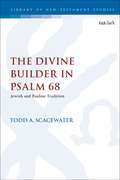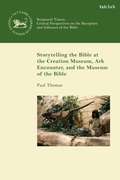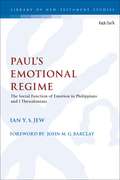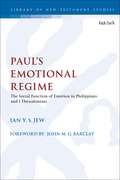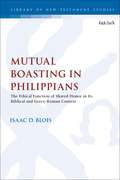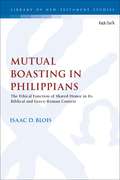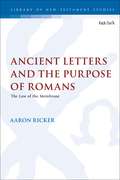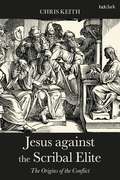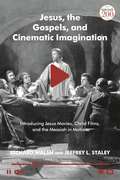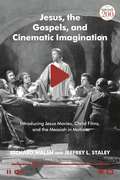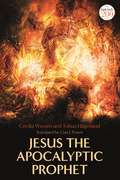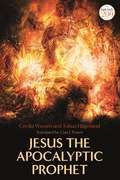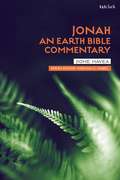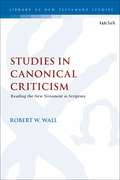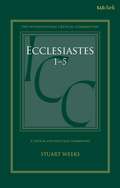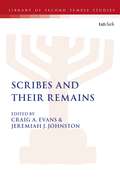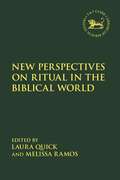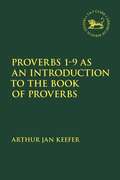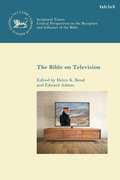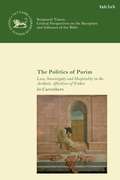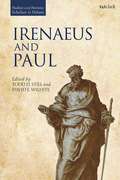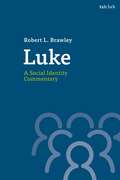- Table View
- List View
The Divine Builder in Psalm 68: Jewish and Pauline Tradition (The Library of New Testament Studies)
by Todd A. ScacewaterThe problem of Psalm 68:19 (Masoretic Text) in Ephesians 4:8 has a rich history of interpretation; particular focus has been placed on Jewish and Pauline interpretations of the psalm, and the Jewish exegetical tradition that reads Moses as the one who ascends Mount Sinai to receive and give the law. Todd Scacewater suggests a second tradition, henceforth unnoticed, that interprets Psalm 68 eschatologically. While both traditions are significant, Scacewater maintains that the eschatological tradition provides a better matrix through which to understand Paul's use of the psalm.Scacewater argues that another key for understanding Pauline use of the psalm is the divine builder topos, which is pervasive in the ancient Near East, utilized in Psalm 68, and evident in Paul's understanding of the psalm as he applies it to Christ, the eschatological divine builder. Discussing the context of Ephesians, the building of the Temple and the trope of the divine builder, and Psalm 68's position in early/late Judaism and Ephesians, Scacewater contributes to a new methodology for studying how the New Testament authors interpreted and appropriated Hebrew Scriptures.
Storytelling the Bible at the Creation Museum, Ark Encounter, and Museum of the Bible (The Library of Hebrew Bible/Old Testament Studies)
by Paul ThomasPaul Thomas chronicles a multi-level reception study of the Bible at both the Creation Museum and the Ark Encounter in Kentucky, USA. Thomas explores the commercial presentation of biblical narratives and the reception of those narratives by the patrons of each attraction, focusing upon three topics; what do young Creationists believe, how they interpret their beliefs from the Bible, and what is the user experience at the museums?The volume begins by explaining how Answers in Genesis (AiG) use Bible passages to support young-Earth creationist arguments, allowing for the chance to consider the Bible via physical means. Thomas then examines how the Creation Museum and the Ark Encounter visitors receive the Bible (as presented by AiG) and how this presentation informs visitors' understanding of the text, exploring concepts such as the most prominent displays of the two attractions, the larger context of museums and theme parks and the case studies of the Methuselah display and The Noah Interview. He concludes with the summary of the user experience generated by the attractions, analyzing the degree to which patrons accept, negotiate, or resist the interpretation of the Bible offered by AiG.
Paul’s Emotional Regime: The Social Function of Emotion in Philippians and 1 Thessalonians (The Library of New Testament Studies)
by Ian Y. JewThis book is the first full-length treatment of emotion in the Pauline corpus. In his letters Paul speaks often of his emotions, and also promotes certain feelings while banishing others. This indicates that for Paul, emotion is vital. However, in New Testament studies, the study of emotions is still nascent; current research in the social sciences highlights its cognitive and social dimensions. Ian Y. S. Jew combines rigoroussocial-scientific analysis and exegetical enquiry to argue that emotions are intrinsic to the formation of the Pauline communities, as they encode belief structures and influence patterns of social experience.By taking joy in Philippians and grief in 1 Thessalonians as representative emotions, and contrasting Paul's approach with that of his Stoic contemporaries, Jew demonstrates that authorised feelings have socially integrating and differentiating functions; by reinforcing the shared theological realities upon which emotional norms are based, group belonging is bolstered. Simultaneously, authorised emotions fortify the theological boundaries between Christians and others, which strengthens group solidarity in the church by accentuating its members' insider status. Using this framework heuristically, Jew explores how the interplay of symbolic, ritual, and social elements within Paul's eschatological worldview reinforces emotional norms, and demonstrates that attention to emotion can only deepen our understanding of the social formation of the early believers.
Paul’s Emotional Regime: The Social Function of Emotion in Philippians and 1 Thessalonians (The Library of New Testament Studies)
by Ian Y. JewThis book is the first full-length treatment of emotion in the Pauline corpus. In his letters Paul speaks often of his emotions, and also promotes certain feelings while banishing others. This indicates that for Paul, emotion is vital. However, in New Testament studies, the study of emotions is still nascent; current research in the social sciences highlights its cognitive and social dimensions. Ian Y. S. Jew combines rigoroussocial-scientific analysis and exegetical enquiry to argue that emotions are intrinsic to the formation of the Pauline communities, as they encode belief structures and influence patterns of social experience.By taking joy in Philippians and grief in 1 Thessalonians as representative emotions, and contrasting Paul's approach with that of his Stoic contemporaries, Jew demonstrates that authorised feelings have socially integrating and differentiating functions; by reinforcing the shared theological realities upon which emotional norms are based, group belonging is bolstered. Simultaneously, authorised emotions fortify the theological boundaries between Christians and others, which strengthens group solidarity in the church by accentuating its members' insider status. Using this framework heuristically, Jew explores how the interplay of symbolic, ritual, and social elements within Paul's eschatological worldview reinforces emotional norms, and demonstrates that attention to emotion can only deepen our understanding of the social formation of the early believers.
Mutual Boasting in Philippians: The Ethical Function of Shared Honor in its Biblical and Greco-Roman Context (The Library of New Testament Studies #627)
by Isaac D. BloisIsaac Blois argues that Paul's focus in Philippians on the mutual boasting shared between himself and his converts draws on the mutual boasting shared between Israel and her covenant God, as apparent in both Deuteronomy and Isaiah. Using the appearance of this central theme in the pivotal passages of Phil 1:25-26 and 2:14-16 as his focus, Blois stresses the integral relation between mutual boasting and the role that it plays in Paul's exhortations to the Philippian believers, exploring its backdrop in both the biblical tradition and the cultures surrounding them.Blois demonstrates how the mutual boasting that Paul shares with his beloved community is culturally appropriate; the sharing of honor among friends and family was common in antiquity, as seen through the epistolary writing of prominent Roman authors such as Cicero, Seneca, and Fronto. In light of the Scriptural and cultural basis for this motif of shared boasting, Blois argues that the apostle is able to deploy the motif in order to motivate an appropriate response from his audience in the letter. Focusing on the prominence of mutual honor and its use for motivation in Philippians 1 and 2, Blois offers a fresh perspective on the exhortative function of the eschatological boasting that is to exist between Paul and his congregation on the day of Christ.
Mutual Boasting in Philippians: The Ethical Function of Shared Honor in its Biblical and Greco-Roman Context (The Library of New Testament Studies)
by Isaac D. BloisIsaac Blois argues that Paul's focus in Philippians on the mutual boasting shared between himself and his converts draws on the mutual boasting shared between Israel and her covenant God, as apparent in both Deuteronomy and Isaiah. Using the appearance of this central theme in the pivotal passages of Phil 1:25-26 and 2:14-16 as his focus, Blois stresses the integral relation between mutual boasting and the role that it plays in Paul's exhortations to the Philippian believers, exploring its backdrop in both the biblical tradition and the cultures surrounding them.Blois demonstrates how the mutual boasting that Paul shares with his beloved community is culturally appropriate; the sharing of honor among friends and family was common in antiquity, as seen through the epistolary writing of prominent Roman authors such as Cicero, Seneca, and Fronto. In light of the Scriptural and cultural basis for this motif of shared boasting, Blois argues that the apostle is able to deploy the motif in order to motivate an appropriate response from his audience in the letter. Focusing on the prominence of mutual honor and its use for motivation in Philippians 1 and 2, Blois offers a fresh perspective on the exhortative function of the eschatological boasting that is to exist between Paul and his congregation on the day of Christ.
Ancient Letters and the Purpose of Romans: The Law of the Membrane (The Library of New Testament Studies #630)
by Aaron RickerAaron Ricker locates the purpose of Romans in its function as a tool of community identity definition. Ricker employs a comparative analysis of the ways in which community identity definition is performed in first-century association culture, including several ancient network letters comparable to Romans. Ricker's examination of the community advice found in Rom 12-15 reveals in this new context an ancient example of the ways in which an inscribed addressee community can be invited in a letter to see and comport itself as a “proper” association network community. The ideal community addressed in the letter to the Romans is defined as properly unified and orderly, as well accommodating to – and clearly distinct from – cultures “outside.” Finally, it is defined as linked to a proper network with recognised leadership (i.e., the inscribed Paul of the letter and his network). Paul's letter to the Romans is in many ways a baffling and extraordinary document. In terms of its community-defining functions and strategies, however, Ricker shows its purpose to be perfectly clear and understandable.
Ancient Letters and the Purpose of Romans: The Law of the Membrane (The Library of New Testament Studies)
by Aaron RickerAaron Ricker locates the purpose of Romans in its function as a tool of community identity definition. Ricker employs a comparative analysis of the ways in which community identity definition is performed in first-century association culture, including several ancient network letters comparable to Romans. Ricker's examination of the community advice found in Rom 12-15 reveals in this new context an ancient example of the ways in which an inscribed addressee community can be invited in a letter to see and comport itself as a “proper” association network community. The ideal community addressed in the letter to the Romans is defined as properly unified and orderly, as well accommodating to – and clearly distinct from – cultures “outside.” Finally, it is defined as linked to a proper network with recognised leadership (i.e., the inscribed Paul of the letter and his network). Paul's letter to the Romans is in many ways a baffling and extraordinary document. In terms of its community-defining functions and strategies, however, Ricker shows its purpose to be perfectly clear and understandable.
Jesus against the Scribal Elite: The Origins of the Conflict
by Chris KeithHow did the controversy between Jesus and the scribal elite begin? We know that it ended on a cross, but what put Jesus on the radar of established religious and political leaders in the first place? Chris Keith argues that an answer to these questions must go beyond typical explanations such as Jesus's alternative views on Torah or his miracle working and consider his status as a teacher.Keith examines Jesus' own likely educational background, and situates Jesus within his first-century context, showing readers that some of the tensions between Jesus and the scribal authorities may have originated in Jesus' own lack of formal education. Keith builds on his earlier work on Jesus' literacy and uses insights from memory theory and ancient media studies to consider how Jesus' actions and teachings may have specifically been seen to challenge an elitist scribal culture.
Jesus against the Scribal Elite: The Origins of the Conflict (Criminal Practice Ser.)
by Chris KeithHow did the controversy between Jesus and the scribal elite begin? We know that it ended on a cross, but what put Jesus on the radar of established religious and political leaders in the first place? Chris Keith argues that an answer to these questions must go beyond typical explanations such as Jesus's alternative views on Torah or his miracle working and consider his status as a teacher.Keith examines Jesus' own likely educational background, and situates Jesus within his first-century context, showing readers that some of the tensions between Jesus and the scribal authorities may have originated in Jesus' own lack of formal education. Keith builds on his earlier work on Jesus' literacy and uses insights from memory theory and ancient media studies to consider how Jesus' actions and teachings may have specifically been seen to challenge an elitist scribal culture.
Jesus, the Gospels, and Cinematic Imagination: Introducing Jesus Movies, Christ Films, and the Messiah in Motion
by Richard Walsh Jeffrey L. StaleyJesus films arose with cinema itself. Richard Walsh and Jeffrey L. Staley introduce students to these films with a general overview of the Jesus film tradition and with specific analyses of 22 of its most influential exemplars, stretching from La vie du Christ (1906) to Mary Magdalene (2018). The introduction to each film includes discussion of plot, characters, visuals, appeal to authority, and cultural location as well as consideration of the director's (and/or other filmmakers') achievements and style. Several film chapters end with reflections on problematic issues bedeviling the tradition, such as cultural imperialism and patriarchy. To assist teachers and researchers, each chapter includes a listing of DVD chapters and the approximate “time” (for both DVDs and streaming platforms) at which key film moments occur. The book also includes a Gospels Harmony cataloging the time at which key gospel incidents appear in these films. Extensive endnotes point readers to other important work on the tradition and specific films. While the authors strive to set the Jesus film tradition within cinema and its interpretation, the DVD/streaming listing and the Gospels Harmony facilitate the comparison of these films to gospel interpretation and the Jesus tradition.
Jesus, the Gospels, and Cinematic Imagination: Introducing Jesus Movies, Christ Films, and the Messiah in Motion
by Richard Walsh Jeffrey L. StaleyJesus films arose with cinema itself. Richard Walsh and Jeffrey L. Staley introduce students to these films with a general overview of the Jesus film tradition and with specific analyses of 22 of its most influential exemplars, stretching from La vie du Christ (1906) to Mary Magdalene (2018). The introduction to each film includes discussion of plot, characters, visuals, appeal to authority, and cultural location as well as consideration of the director's (and/or other filmmakers') achievements and style. Several film chapters end with reflections on problematic issues bedeviling the tradition, such as cultural imperialism and patriarchy. To assist teachers and researchers, each chapter includes a listing of DVD chapters and the approximate “time” (for both DVDs and streaming platforms) at which key film moments occur. The book also includes a Gospels Harmony cataloging the time at which key gospel incidents appear in these films. Extensive endnotes point readers to other important work on the tradition and specific films. While the authors strive to set the Jesus film tradition within cinema and its interpretation, the DVD/streaming listing and the Gospels Harmony facilitate the comparison of these films to gospel interpretation and the Jesus tradition.
Jesus the Apocalyptic Prophet
by Cecilia Wassen Tobias HägerlandIn this new English language translation of Den okände Jesus (The Unknown Jesus), Cecilia Wassén and Tobias Hägerland consider Jesus as an apocalyptic prophetic figure within the context of first-century Judaism and reconstruct the life of Jesus from his birth to his death, with a focus on understanding him in the context of his own time and place. Engaging critically with the sources, they examine Jesus' life in order of events and draw together the threads of scholarly discussion on the history, archaeology and geography of first-century Galilee, forming a complete picture of Jesus' world suitable for non-specialists and university students.Wassén and Hägerland provide a strictly historical reconstruction, distinguishing between the rhetorical aims of the New Testament texts and the information about the past that these texts contain. They enhance the texts surrounding Jesus in the context of first-century Galilee with historical and archaeological reflections and discussion, including penetrating insights from the Dead Sea Scrolls. Illustrated throughout with photographs taken by the authors specifically to offer insights into the world of Jesus and the New Testament writings, Jesus the Apocalyptic Prophet provides a deeply informed introduction to Jesus in his first-century context.
Jesus the Apocalyptic Prophet
by Cecilia Wassen Tobias HägerlandIn this new English language translation of Den okände Jesus (The Unknown Jesus), Cecilia Wassén and Tobias Hägerland consider Jesus as an apocalyptic prophetic figure within the context of first-century Judaism and reconstruct the life of Jesus from his birth to his death, with a focus on understanding him in the context of his own time and place. Engaging critically with the sources, they examine Jesus' life in order of events and draw together the threads of scholarly discussion on the history, archaeology and geography of first-century Galilee, forming a complete picture of Jesus' world suitable for non-specialists and university students.Wassén and Hägerland provide a strictly historical reconstruction, distinguishing between the rhetorical aims of the New Testament texts and the information about the past that these texts contain. They enhance the texts surrounding Jesus in the context of first-century Galilee with historical and archaeological reflections and discussion, including penetrating insights from the Dead Sea Scrolls. Illustrated throughout with photographs taken by the authors specifically to offer insights into the world of Jesus and the New Testament writings, Jesus the Apocalyptic Prophet provides a deeply informed introduction to Jesus in his first-century context.
Jonah: An Earth Bible Commentary (Earth Bible Commentary)
by Jione HaveaJione Havea analyses the Book of Jonah through the lens of climate change, using this present situation to reconsider the significance of Jonah for contemporary struggles and contexts, and tapping into traditional practices of commentary to draw out the meaning of the biblical text. Havea takes Jonah 3:10 as a starting point, in which God repents and rethinks (decides not to destroy), taking this as a challenge and an opportunity for biblical scholars to reflect on the realities of climate change. Havea builds on this opportunity in two ways: first, by reading Jonah forward, giving special attention to the orientation of the narrative toward the sea and Nineveh, and then backward, highlighting the significance of sea and (is)land lives to the flow of the narrative. Second, by looking at the other figures in the narrative, rather than focusing on the narrator's obsession with Jonah and his God. Havea reminds readers that the fish, plant, worm and other beasts are also crucial in this narrative, and considers how this can change our reading of the text.
Studies in Canonical Criticism: Reading the New Testament as Scripture (The Library of New Testament Studies #No. 76)
by Robert W. WallAs one of the leading figures in New Testament studies, Robert W. Wall has continually focused on the function of the New Testament as a "canonical” or authoritative collection of writings, reflecting not only the content and essence of the Church's emerging faith, but also the life to that community of followers of Jesus who eventually became widely known as “Christians.” In the vein of his defining work, The New Testament as Canon: A Reader in Canonical Criticism, Wall now reflects upon his more recent body of study.Always emphasizing 'canonical conversation', Wall had collected and revised some of his most important essays of the last two decades, including Unity of Luke and Acts (2010), The Unifying Theology of the Catholic Epistles (2003-13) and Images of Church in John's Revelation (2015). Completed by a new essay on the canonical approach to the Paratext of Hebrews, and with vital "introductory notes" for each chapter that highlight both Wall's revisions and his response to critical reception, this book is yet one more asset in Wall's continuing pursuit of the canonical function of the church's Scriptures.
Studies in Canonical Criticism: Reading the New Testament as Scripture (The Library of New Testament Studies #No. 76)
by Robert W. WallAs one of the leading figures in New Testament studies, Robert W. Wall has continually focused on the function of the New Testament as a "canonical” or authoritative collection of writings, reflecting not only the content and essence of the Church's emerging faith, but also the life to that community of followers of Jesus who eventually became widely known as “Christians.” In the vein of his defining work, The New Testament as Canon: A Reader in Canonical Criticism, Wall now reflects upon his more recent body of study.Always emphasizing 'canonical conversation', Wall had collected and revised some of his most important essays of the last two decades, including Unity of Luke and Acts (2010), The Unifying Theology of the Catholic Epistles (2003-13) and Images of Church in John's Revelation (2015). Completed by a new essay on the canonical approach to the Paratext of Hebrews, and with vital "introductory notes" for each chapter that highlight both Wall's revisions and his response to critical reception, this book is yet one more asset in Wall's continuing pursuit of the canonical function of the church's Scriptures.
Ecclesiastes 1-5: A Critical and Exegetical Commentary (PDF)
by Stuart WeeksThis new volume in the ICC on Ecclesiastes 1-5 brings together all the relevant aids to exegesis - linguistic, textual, archaeological, historical, literary and theological - to enable the scholar to have a complete knowledge and understanding of this Old Testament book. Stuart Weeks incorporates new evidence available in the field, surveys the wealth of secondary literature and provides an extensive introduction to Ecclesiastes as a whole.
Scribes and Their Remains (The Library of Second Temple Studies)
by Craig A. Evans Jeremiah J. JohnstonScribes and Their Remains begins with an introductory essay by Stanley Porter which addresses the principal theme of the book: the text as artifact. The rest of the volume is then split into two major sections. In the first, five studies appear on the theme of 'Scribes, Letters, and Literacy.' In the first of these Craig A. Evans offers a lengthy piece that argues that the archaeological, artifactual, and historical evidence suggests that New Testament autographs and first copies may well have remained in circulation for one century or more, having the effect of stabilizing the text. Other pieces in the section address literacy, orality and paleography of early Christian papyri. In the second section there are five pieces on 'Writing, Reading, and Abbreviating Christian Scripture.' These range across numerous topics, including an examination of the stauros (cross) as a nomen sacrum. The volume concludes with reflections by co-editor Peter Arzt-Grabner incorporating his longstanding expertise in the study of documentary papyri, especially as these ancient documents relate to New Testament research. From the perspective of a papyrologist, Arzt-Grabner discusses how New Testament scholars use documentary papyri today and recommends some future directions.
New Perspectives on Ritual in the Biblical World (The Library of Hebrew Bible/Old Testament Studies)
This volume presents a range of methodologically innovative treatments on ritual action in the Hebrew Bible. They treat a diverse range of ritual phenomena, including space, blessings and oath-taking, from the world of ancient Israel and Judah.The introduction engages with the dominant scholarly models drawn from ritual theory, and the volume explores their applicability to ancient textual material such as the Hebrew Bible. The chapters reflect high-level specialized engagement with specific ritual phenomena through the lens of appropriate theoretical and methodological approaches.
Proverbs 1-9 as an Introduction to the Book of Proverbs (The Library of Hebrew Bible/Old Testament Studies)
by Arthur Jan KeeferProverbs 1-9 has long been called a 'prologue' and 'introduction' to the book of Proverbs, a label that this book clarifies by answering the question: how does Proverbs 1-9 function with respect to the interpretation of Proverbs 10-31? Arthur Keefer argues that, in the detail and holistic context of Proverbs, Proverbs 1-9 functions didactically by supplying interpretive frameworks in literary, rhetorical and theological contexts for representative portions of Proverbs 10-31. Keefer suggests that Proverbs 1-9 functions didactically by teaching interpretive skills, and allows interpretation of Proverbs 10-31 by instilling the competence required to explicate this material. As a result, Proverbs 1-9 provides a didactic introduction for the remainder of the book, particularly with respect to its character types, educational goals, and theology. This volume demonstrates the function of Proverbs 1-9 for Proverbs 10-31 in some of the most prominent interpretive contexts of the book, and in doing so advances current key interpretive debates within Proverbs scholarship.
The Bible on Television (The Library of New Testament Studies)
by Helen K. Bond Edward AdamsThis volume examines and discusses selected Bible documentaries and academically informed dramatizations of the Bible. With a major focus on recent productions in UK mainline television within the past 15 years, the contributors also engage with productions from the USA.After a critical introduction by Helen K. Bond, charting and reflecting on the use of the Bible on television in recent years, the book falls into three sections. First, a number of influential filmmakers and producers, including Ray Bruce and Jean- Claude Bragard, discuss their work in relation to the context and constraints oftelevision - especially religious television - programming. The volume then moves to reflections of various academics who have acted as 'talking heads', historical consultants and presenters, allowing discussion of different aspects of the process, including the extent to which they had influence and how their contributions were used. Finally, a number of scholars assess the finished products, discussing what they tell us about the modern reception of the Bible, with additional consideration of how these productions influence biblical scholars and contribute to the scholarly agenda.
The Politics of Purim: Law, Sovereignty and Hospitality in the Aesthetic Afterlives of Esther (The Library of Hebrew Bible/Old Testament Studies)
by Jo CarruthersThis book approaches the holiday of Purim as profane, freed to human use and ends, in order to consider the political legacy of the biblical story of Esther in festival and art works. Jo Carruthers explores carnival and synagogue practices, the purimshpiln (Purim's own dramatic genre), illuminated Esther scrolls, as well as artworks by Botticelli, Millais and Jan Steen. The complex and astute interrogation of political life in such festival and artworks is analysed through theories of sovereignty, law, precarity and hospitality by key political thinkers such as Giorgio Agamben, Hannah Arendt, Walter Benjamin, Judith Butler, Jacques Derrida, and Jacques Rancière. Carruthers considers different motifs of boundary conservation and dissolution, as a means of contemplating the political implications of Purim and the Esther story for diaspora politics. How is sovereignty aspired to and attained by marginalized and threatened communities? How can one respond to the ethical call of hospitality to relax sovereign boundaries whilst protecting and celebrating that which is exceptional? The practice of giving gifts, mishloach manos, offers a model of hospitality that together with Purim's profane impulse is epitomized in the final chapter's discussion of a 2018 Brooklyn purimshpil, that offers a riotous ridiculing of white supremacist rhetoric, norms of domination, capitalist inequalities, modern slavery and ablest identities and assumptions.
Irenaeus and Paul (Pauline and Patristic Scholars in Debate)
by Todd D. Still David E. WilhiteBuilding on the work of Tertullian and Paul and The Apostolic Fathers and Paul this volume continues a series of specially commissioned studies by leading voices in New Testament/early Christianity and patristics studies to consider how Paul was read, interpreted and received by the Church Fathers. In this volume the use of Paul's writings is examined within the writings of Irenaeus of Lyon. Issues of influence, reception, theology and history are examined to show how Paul's work influenced the developing theology of the early Church. The literary style of Paul's output is also examined. The contributors to the volume represent leading lights in the study of Irenaeus, as well as respected names from the field of New Testament studies.
Luke: Method And Message In Luke-acts (T&T Clark Social Identity Commentaries on the New Testament)
by Robert L. BrawleyIn this commentary, Robert L. Brawley provides comprehensive coverage of issues and concerns related to Luke from the perspective of social identity. He argues that the Gospel of Luke is strongly concerned with the formation of identity from the very start of the text, which aims at the creation of a socially responsible community in continuity with that community's collective past.Brawley establishes a theoretical framework that focuses his interpretation - ranging from the narrative world and sociological issues to postcolonialism and hierarchies of dominance - and uses these perspectives to provide a clear overview of historical and critical issues related to an understanding of Luke. He then provides a thorough outline of and commentary on the text of the Gospel. Brawley's engagement with the text serves as an invaluable resource for scholars, students, clergy, and others interested in their own discoveries of the resources of Luke.
